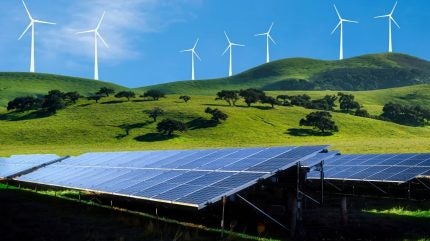
India’s power sector has achieved a major milestone by surpassing 500GW of installed electricity capacity as of 30 September 2025, according to Pralhad Joshi, the country’s energy minister.
The nation achieved a capacity of 500.89GW, with more than half derived from renewable sources, driven by sustained policy support, investments, and teamwork within the dometic energy sector over the years.

Discover B2B Marketing That Performs
Combine business intelligence and editorial excellence to reach engaged professionals across 36 leading media platforms.
Specifically, India’s power capacity consists of 256.09GW from nonfossil fuel sources, making up more than 51% of the overall capacity.
In contrast, fossil-fuel-based sources contribute 244.80GW, representing roughly 49% of the total.
Among the renewable energy sources, solar power accounts for 127.33GW while wind power accounts for 53.12GW.
In financial year 2025-26, India expanded its energy infrastructure by adding 28GW of nonfossil-fuel capacity alongside 5.1GW of fossil-fuel capacity, showcasing the rapid growth of clean energy.

US Tariffs are shifting - will you react or anticipate?
Don’t let policy changes catch you off guard. Stay proactive with real-time data and expert analysis.
By GlobalDataOn 29 July 2025, the country achieved its highest renewable energy share in electricity generation, with renewables contributing 51.5% of the nation’s total electricity demand, which stood at 203GW.
This accomplishment propels India towards achieving one of its major Conference of the Parties 26 Panchamrit goals of attaining 50% of installed electric power capacity from nonfossil-fuel sources by 2030, five years ahead of schedule.
This progress underscores India’s leadership in the clean energy transition while ensuring grid stability.
Additionally, India’s renewable energy push is generating new job opportunities, benefiting both rural and urban youth.
India has ascended to become the fourth-largest producer of renewable energy globally with an installed capacity of 257GW, marking a three-fold increase from 81GW in 2014, the Union minister added.
India intends to allocate Rs2.21bn ($25m) to the Africa Solar Facility through the International Solar Alliance to aid the development of mini-grids and distributed renewable energy projects.
In a similar scenario, India is contemplating a bailout of over Rs1tn for state-run power distribution companies burdened with debt, reported Reuters.
According to three government officials and a document prepared by the Indian Ministry of Power, the states seeking to receive bailout funds must either privatise their electric utilities and transfer managerial control or retain control while listing them on a stock exchange.
According to the Power Ministry presentation, the proposal requires that private companies supply at least 20% of the state’s overall power consumption.
Private companies like Adani Power, Reliance Power, Tata Power, CESC, and Torrent Power are anticipated to gain advantages from these reforms, as they are expected to acquire interests in state-owned companies.



